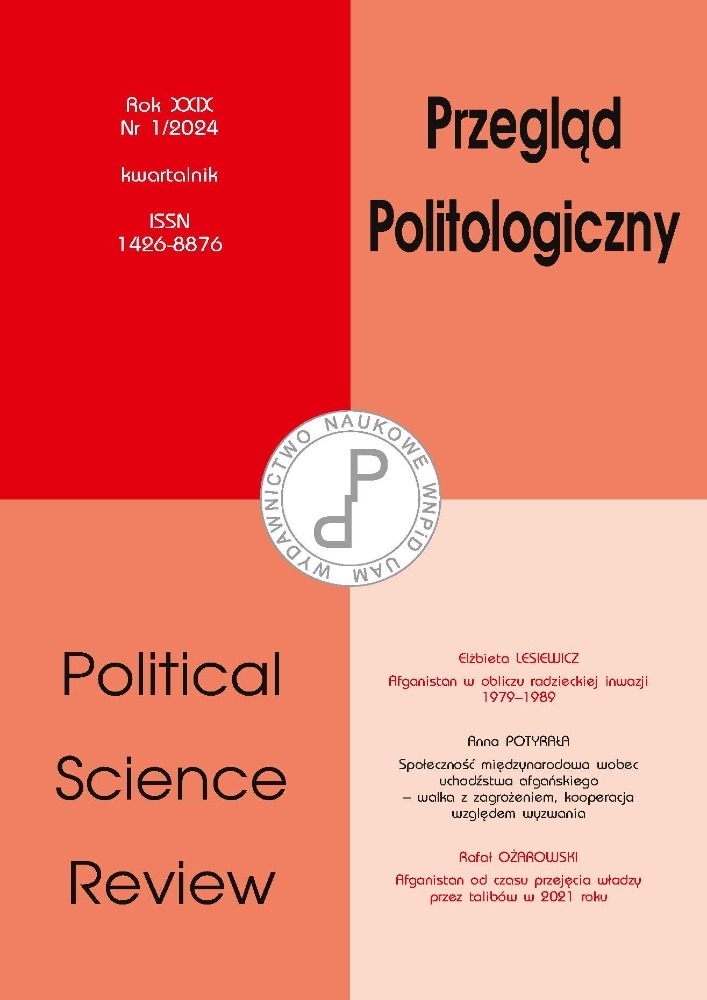Abstract
The article is devoted to the specific analysis of the changes that have taken place in the perception of the status of women in Afghanistan. The state, also known as the Islamic Emirate of Afghanistan, is an area where the level of gender inequality and discrimination is one of the highest in the world. The origins of Afghan statehood date back to the eighteenth century. Over the years, the local community has faced numerous armed conflicts, the basis of which can be found both in the interventions of third countries and in internal problems. These include, for example, ethnic conflicts or extreme religious extremism.
The first part of this article contains the analysis of the position of women in the light of Islam and Middle Eastern traditions. The author points to two main determinants that have a real and significant impact on the scope of the rights granted to an individual. She points them out consecutively: religion – as a factor shaping the mentality of each group, as well as the patriarchal model of society, determined by the physical, mental and spiritual spheres of a human being.
In the second part, the author describes the socio-cultural changes that took place in 2021, i.e. after the Taliban took power again. It refers to the laws and regulations that were introduced in the Islamic Emirate of Afghanistan.
The third part contains references to the assumptions of international law and all other acts that deal with the issue of discrimination against women and other disadvantaged groups under national law. To better explain the issue, a definition of the term “discrimination” is also provided.
In the last part of the paper, the author describes the current position of women in Afghanistan and at the same time, she presents her observations on the rate of change in the mentality of the local community.
References
Central Asia Institute (2017), The Fight for Women’s Voting Rights, https://centralasiainstitute.org/womens-voting-rights/, 6.02.2022.
European Network of Migrant Women (ENOMW) (2021), Statement on the Situation in Afghanistan and the Rights of Afghan Women and Girls.
Franceschet S., Krook M. L., Tan N. (2018), The Palgrave Handbook of Women’s Political Rights, “Palgrave Macmillan”. DOI: https://doi.org/10.1057/978-1-137-59074-9
Ghufran N. (2001), The Taliban and the Civil War entanglement in Afghanistan, “Asian Survey”, vol. 41, nr 3. DOI: https://doi.org/10.1525/as.2001.41.3.462
Human Rights Watch (2011), Afghanistan: Stop Women Being Given as Compensation, https://www.hrw.org/news/2011/03/08/afghanistan-stop-women-being-given-compensation, 3.02.2022.
Islamic Republic of Afghanistan – Ministry of Justice (2009), Law on Elimination of Violence against Women (EVAW), Chapter 1, art. 3.
Jureńczyk Ł. (2019a), Partycypacja kobiet w systemie politycznym Afganistanu w XXI wieku, „Przegląd Politologiczny”, nr 1. DOI: https://doi.org/10.14746/pp.2019.24.1.7
Jureńczyk Ł. (2019b), Społeczna pozycja kobiet w Afganistanie po 2014 rok, „Problemy Polityki Społecznej”, vol. 45. DOI: https://doi.org/10.31971/16401808.45.2.2019.1
Konstytucja Rzeczypospolitej Polskiej (1997), Rozdział II – Prawa, wolności i obowiązki człowieka i obywatela, art. 32, ust. 1–2.
Machut-Mendecka E. (2018), Czas hidż abu. Konteksty kultury arabskiej, Katedra Arabistyki i Islamistyki Uniwersytetu Warszawskiego, Warszawa.
Ministerstwo Kultury i Dziedzictwa Narodowego (2015), Czym jest dyskryminacja i równe traktowanie, „Biuletyn informacji publicznej”, https://bip.mkidn.gov.pl/pages/koordynator-do-spraw-rownego-traktowania/czym-jest-dyskryminacja-i-rowne-traktowanie.php, 1.02.2022.
Medica mondiale (2021), Where we work: Afghanistan, https://www.medicamondiale.org/en/where-we-work/afghanistan.html, 10.02.2022.
Ministry of Foreign Affairs of Afghanistan (2015), Afghanistan’s National Action Plan on UNSCR 1325 Women, Peace and Security.
Mujahid Z. (2021), Special Decree Issued by Amir al-Momenin on Women’s Rights, no. 395, https://twitter.com/Zabehulah_M33/status/1466663907750256642?ref_src=twsrc%5Etfw, 6.02.2022.
Organizacja Narodów Zjednoczonych (1979), Konwencja w sprawie likwidacji wszelkich form dyskryminacji kobiet, art. 2.
Organizacja Narodów Zjednoczonych (1948), Powszechna Deklaracja Praw Człowieka, Nowy Jork.
UN Women (2021), Women’s rights in Afghanistan: Where are we now?, “Gender alert”, nr 1.
Parlament Europejski (2021), Posłowie chcą specjalnego programu wizowego dla afgańskich kobiet szukających ochrony – Komunikat prasowy, https://www.europarl.europa.eu/news/pl/press-room/20210910IPR11906/poslowie-chca-specjalnego-programu-wizowego-dla-afganskich-kobiet, 6.02.2022.
Parlament Europejski (2009), Rezolucja Parlamentu Europejskiego z dnia 24 kwietnia 2009 r. w sprawie praw kobiet w Afganistanie, P6_TA(2009)0309.
Prochwicz-Studnicka B., Teperska-Klasińska M. (2012), Cywilizacja islamu. Wybrane struktury, “The Polish Journal of the Arts and Culture”, nr 3.
Rashid A. (2000), Taliban: Islam, Oil and the New Great Game in Central Asia, New York.
Rzecznik Praw Obywatelskich (2014), Czym jest dyskryminacja, Biuletyn Informacji Publicznej RPO, https://bip.brpo.gov.pl/pl/content/czym-jest-dyskryminacja, 1.02.2022.
Sadowa K. (2013), Sytuacja kobiet w Islamie, w: Acta Erasmiana, tom 5: Varia, red. M. Sadowski, Wrocław.
Sankey M. D. (2018), Women and War in the 21st Century: A Country-by-Country Guide, “ABC-CLIO”. DOI: https://doi.org/10.5040/9798216036890
The Constitution of Afghanistan (2004), Chapter 2, art. 22.
Walby S. (1990), Theorizing Patriarchy, “Basil Blackwell”, Cambridge.
Women’s International League of Peace and Freedom, Afghanistan, http://1325naps.peacewomen.org/index.php/afghanistan/, 5.02.2022.
Yousaf F., Jabarkhail M. (2021), US withdrawal and the Taliban regime in Afghanistan: Future Policy Directions, “Swisspeace”, Policy Brief, nr 5.
License
Copyright (c) 2024 Natalia Potera

This work is licensed under a Creative Commons Attribution-ShareAlike 4.0 International License.

